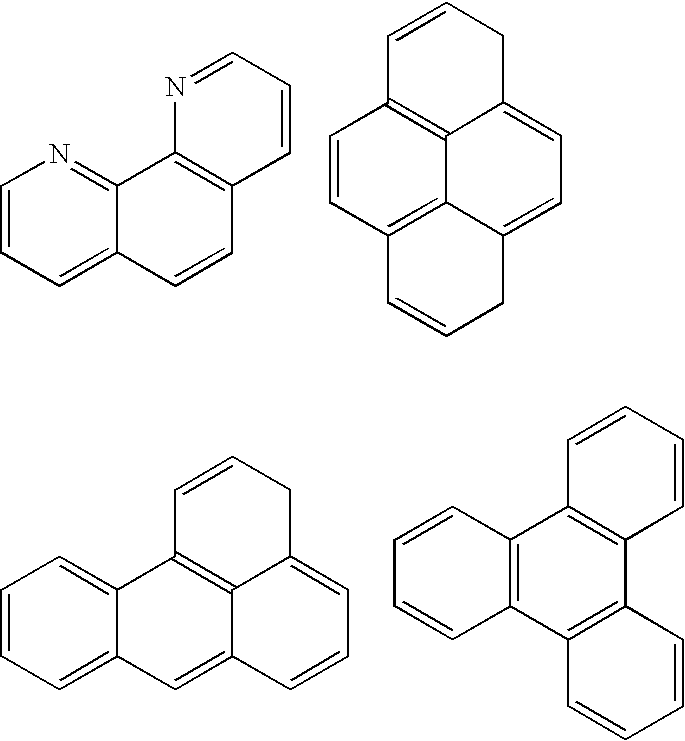Advanced preparation method of organic-transition metal hydride complexes as hydrogen storage materials
a technology of metal hydride and complex, which is applied in the direction of group 3/13 element organic compounds, group 5/15 element organic compounds, etc., can solve the problems of difficult commercialization, less than reference value of hydrogen storage, and difficult separation of naoh and target compounds from each other, so as to achieve stable reaction and less stringent reaction conditions. , the effect of high yield
- Summary
- Abstract
- Description
- Claims
- Application Information
AI Technical Summary
Benefits of technology
Problems solved by technology
Method used
Image
Examples
preparation example 2
[0063]MAH Method II: Hydrodehalogenation Reaction
[0064]Phenoxytitanium aluminum hydride complexes (target compound A) were obtained at a yield of 96% by performing the same method except for using 0.262 g (4.85 mmol) NaAlH4 instead of using Li AlH4 in Example 1
[0065]1H-NMR (CD3CN-d3) δ (ppm): 7.28(d, 1H), 6.95(t, 2H), 6.85(t, 2H), 7.60 (s, 1H), 4.81 (s, 1H), 4.24(s, 1H), −1.61 (s, 1H), −2.29(s, 1H) ESI-MS (positive mode), m / z(relative intensity): [parent molecule]+ 171(9.9), 172(9.4), 173(100), 174(23), 175(10.1) Anal. Calc. for parent molecule: C, 41.6; H, 5.8. Found: C, 41.9; H, 5.5%.
[0066]In order to examine kinds of by-products prepared according to the MAH method II and the preferred separation phenomenon of the target compound A having high selectivity, it can be appreciated from analysis results of XRD, 35Cl-NMR, and 27Al-NMR on the target compound A before the purification (As-synthesis) and the target compound A after the purification that NaCl and Al can be formed as main ...
example 1
[0067]LB Method I: Hydrogenation Reaction
[0068]0.4 g (2.3 mmol) phenoxytitanium aluminum hydride complexes prepared according to Preparation Example 1 are dissolved (reactant IV) with 30 ml tetrahydrofuran (THF) within a container of a 100 ml 2-neck round flask under argon air stream. 0.70 g (6.9 mmol) trimethylamine is dissolved (reactant III) with 70 ml tetrahydrofuran (THF) in a container of a 250 ml one-neck round flask under argon air stream. After a reflux is made at 25° C. for 12 hours while the reactant IV slowly drops in the reactant III, the reaction is complete. Solvents are removed by a Schlenk method under argon atmosphere and then, only phenoxytitanium hydride (a target compound B) is selectively extracted using 2-propanol from an as-synthesis material B. Thereafter, 2-propanol is removed by the Schlenk method such that phenoxytitanium aluminum hydride complexes (target compounds B) were obtained at a yield of 98%.
[0069]1H-NMR (CD3CN-d3) δ (ppm): 7.28(d, 1H), 6.95(t, 2...
example 2
[0071]LB Method II: Hydrogenation Reaction
[0072]0.4 g (2.3 mmol) phenoxytitanium aluminum hydride complexes prepared according to Preparation Example 1 are dissolved (reactant IV) with 30 ml tetrahydrofuran (THF) within a container of a 100 ml 2-neck round flask under argon air stream. 0.44 g (6.9 mmol) butyl lithium is dissolved (reactant III) with 70 ml tetrahydrofuran in a container of a 250 ml one-neck round flask under argon air stream. After a reflux is made at 25° C. for 16 hours while the reactant IV slowly drops in the reactant III, the reaction completes. Solvents are removed by a Schlenk method under argon atmosphere and then, only phenoxytitanium hydride (a target compound B) is selectively extracted using 2-propanol from an as-synthesis material 1. Thereafter, 2-propanol is removed by the Schlenk method such that phenoxytitanium hydride (target compounds B) were obtained at a yield of 95%.
[0073]1H-NMR (CD3CN-d3) δ (ppm): 7.28(d, 1H), 6.95(t, 2H), 6.85(t, 2H), 7.60 (s, 3...
PUM
| Property | Measurement | Unit |
|---|---|---|
| temperature | aaaaa | aaaaa |
| valence | aaaaa | aaaaa |
| weight | aaaaa | aaaaa |
Abstract
Description
Claims
Application Information
 Login to View More
Login to View More - R&D
- Intellectual Property
- Life Sciences
- Materials
- Tech Scout
- Unparalleled Data Quality
- Higher Quality Content
- 60% Fewer Hallucinations
Browse by: Latest US Patents, China's latest patents, Technical Efficacy Thesaurus, Application Domain, Technology Topic, Popular Technical Reports.
© 2025 PatSnap. All rights reserved.Legal|Privacy policy|Modern Slavery Act Transparency Statement|Sitemap|About US| Contact US: help@patsnap.com



